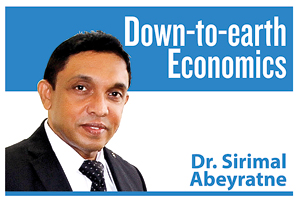Business as unusual
View(s):
Night scene of the Chongqing city in Southwest China. Pic by Dr. Shuwen Yan.
China often moves away from “business-as-usual” norms by doing things differently and doing different things deliberately. Its “National New-type Urbanisation Plan 2014-2020” was one of such businesses completed last year. It planned for facilitating initially 100 million rural migrants to become urban residents! In other words, it was a development plan to expand cities by providing urban facilities and services including housing to the rural farmers migrating to urban cities.
I am sure this is a shocking news to some of us who think otherwise: Why on earth do we in Sri Lanka ever think of converting our rural farmers to urban dwellers by imprisoning them in multi-storied housing schemes? We have done so much for the rural population of this country throughout our 72-year long post-independent history. Still our authorities visit them frequently and, enquire about how they do, but never wanted to give them any hope of moving to a city.
Apparently, one could argue that China had regulations preventing the urban residency of rural migrants, which Sri Lanka never had. However, we had government assistance and incentives to keep the rural farmers in the rural sector and, expensive housing and high living cost in the cities preventing them from residing in urban cities. Therefore, we also have millions of people coming to cities every day, every week or every month for work.
Unshakable rural folk
In 1980, the rural population in Sri Lanka was 81 percent of the total. Forty years later, even now Sri Lanka’s rural population is 81 percent of the entire population! This comparison is utterly confusing to anyone who knows the inevitable demographic changes of economic development. It is not a surprise, even if somebody is tempted to ask whether Sri Lanka has a “developing” economy.
During the past 40 years, the Sri Lankan population has increased by more than five million. If the rural population share has not changed, it means more people are scattered in the same rural setting. In fact, since the time of independence, our population has trebled, but many of these people have scattered stretching the country’s rural land without concentrating much in urban locations.
Along with economic development, technically the rural population share should fall and, its urban population share should rise. If development is fast, this demographic change would be fast too.
 All rich countries have a rural population share of around 20 percent, while in smaller rich countries this share is much smaller such as in Israel and the Netherlands. On average, high-income countries have a rural population share of 18 percent. The rural population share of low-income countries is 67 percent, but Sri Lanka’s figure is much higher than even the low-income country average.
All rich countries have a rural population share of around 20 percent, while in smaller rich countries this share is much smaller such as in Israel and the Netherlands. On average, high-income countries have a rural population share of 18 percent. The rural population share of low-income countries is 67 percent, but Sri Lanka’s figure is much higher than even the low-income country average.
Structural changes
Economic growth creates ‘structural changes’ in the form of changes in output, employment and demography. Traditionally, the economies of any country are dominated by rural populations, while most of these people are engaged in domestic agricultural activities.
Economic growth comes with expansion of non-agricultural sectors (that is industry and services sectors) faster than the agriculture sector. Consequently, there would be a couple of changes that we can observe.
Firstly, the share of agriculture output declines with the corresponding increase in the non-agriculture output. This is the reason why we would often see that the non-agriculture output in rich countries remains as high as 98 – 99 percent of GDP; this leaves only 1 – 2 percent of GDP emanating from the agriculture sector, though it does not mean at all a decline in agriculture output in absolute terms.
Secondly, the expansion of non-agriculture sectors does not take place without people leaving the domestic agriculture sector and joining the non-agriculture sectors. This means that there will be changes in employment composition; labour force share in agriculture should fall, with a corresponding increase in employment in non-agriculture sectors. In rich countries, generally, 2 – 3 percent of working population is occupied in the agriculture sector, as the balance would be found working in non-agriculture sectors.
 Finally, the above two-fold structural changes would result in the composition of urban-rural population share. It is because primarily most of the fast-growing non-agricultural sectors are more urbanised than agriculture.
Finally, the above two-fold structural changes would result in the composition of urban-rural population share. It is because primarily most of the fast-growing non-agricultural sectors are more urbanised than agriculture.
Development without
urbanisation
The above discussion leads to one fundamental feature of economic development, which baffles our understanding; development requires urbanisation! It was because of this requirement that China brought out its 6-year National New-type Urbanisation Plan which had four objectives to achieve: Converting rural migrants into urban residents, optimising urbanisation patterns, enhancing the sustainability of cities and, promoting urban-rural integration.
China also had a rural population share of 81 percent of the total in 1980 – that is, two years after embarking on its market-oriented policy reforms. Due to rapid economic growth, its rural population share had declined to 50 percent by 2010 and, to 39 percent by 2020; however, from China’s point of view, this decline in rural population share was not fast enough and not satisfactory. The New-type Urbanisation Plan was intended to remove the existing obstacles to rural migration, facilitate urban living and accelerate the change in rural-urban population composition.
As many analysts have categorically stated in their studies on the issue, the Chinese government had a “hidden agenda” behind its New-type Urbanisation Plan; that is accelerating economic development of China! How does it accelerate economic development?
Concentrated populations bring about a fast-track of the growth process based on industry and service sectors, while maintaining higher productivity. Even for the government, it is easier to provide benefits of development to concentrated populations – housing, health care, education, utilities such as electricity, communication, water and sanitation, road network, markets and other urban services – than to the scattered populations. It is very difficult to provide all that to remote rural settings. Thus, the Chinese government can raise domestic demand too in addition to the international demand for Chinese products.
As a by-product of urbanisation, the rural agriculture sector can also become more productive because ‘excess labour’ from the rural sector is absorbed by the urban sector and the small farm plots can transform into large-scale farm plots, as part of the rural populations leave. In fact, studies have confirmed that as a result of the urbanisation plan, rural land sales have escalated.
Lessons for Sri Lanka
From a development angle, the stagnant rural population share of Sri Lanka provides undisputable evidence on sluggish growth performance of
Sri Lanka as well as an urban labour shortage of the country. One could argue that the outdated rural-urban classification system of Sri Lanka has resulted in distorted rural-urban population compositions.
In the absence of a scientific classification system, Sri Lanka’s urban-rural distinction is based on administrative boundaries – Municipalities, Town Councils and Pradeshiya Sabhas adopted after 1987 -, while the former is classified as “urban” and, the latter two as “rural”. Having understood the problem of the urban-rural classification in Sri Lanka and, more than that the misleading analytics that are carried out on the basis of wrong classifications, there have been sporadic attempts to produce alternative classifications.
Although we attempt to keep the rural communities in the rural sector, education is one of the strong incentives for the younger generations to look for living in urban sectors and working in non-agriculture sectors. Reskilling and retooling the rural youth to work in the non-agricultural sectors and accommodating them in the urban sectors is a short-cut for both accelerating growth and redistributing benefits of growth. It would also reduce the development cost of the government.
(The writer is a Professor of Economics at the University of Colombo and can be reached
at sirimal@econ.cmb.ac.lk and follow on Twitter @SirimalAshoka).


